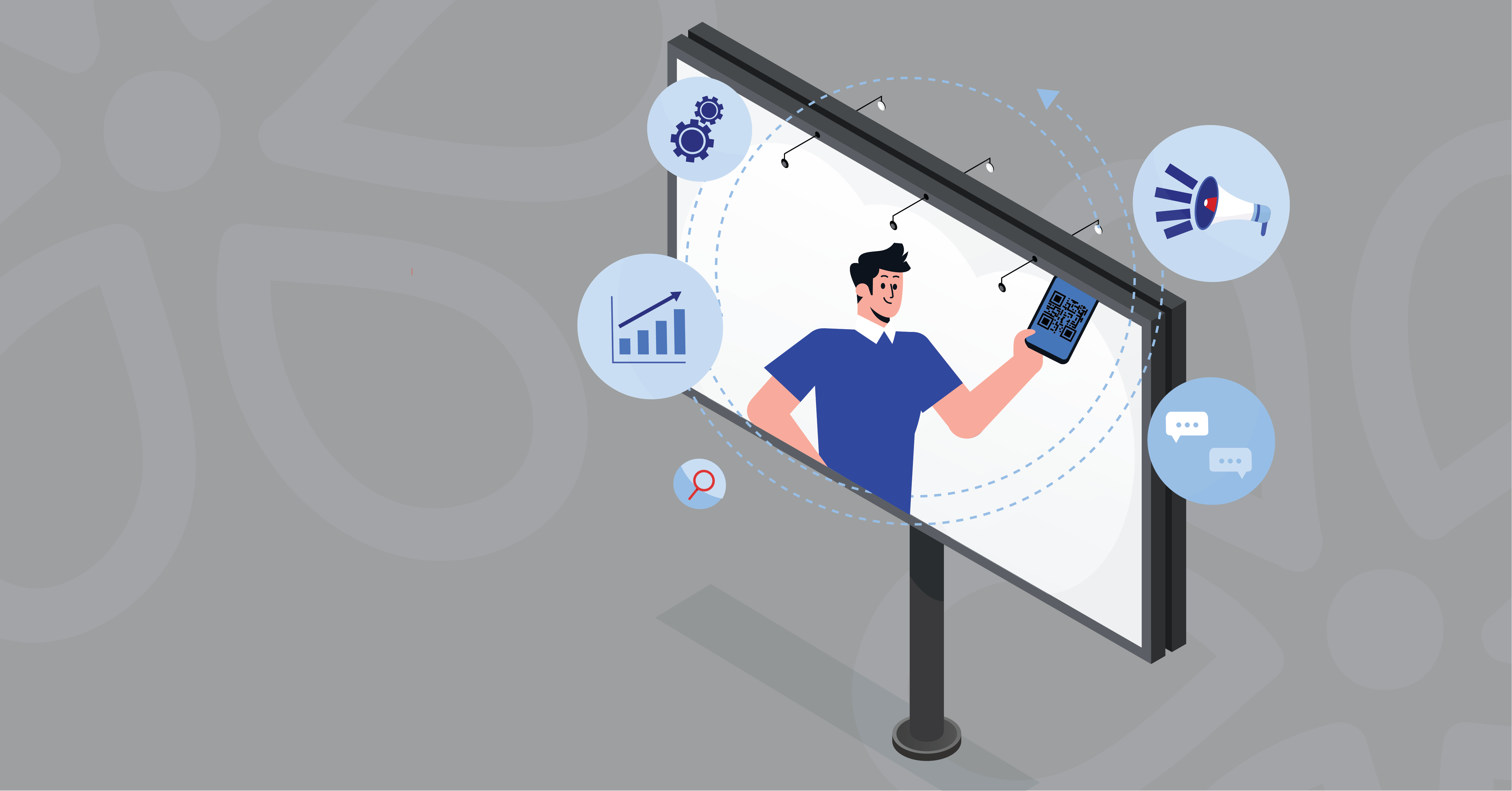How digital out-of-home advertising benefits your business
Technology touches every aspect of our lives, including marketing, so it was only a matter of time until the outdoor environment – long the territory of the interstate billboard or transit ads on the side of a bus – became digitized.
Enter digital out-of-home advertising (DOOH), where marketers are now applying digital tricks to analog formats. DOOH, on its simplest level, involves taking traditional out-of-home and adding more eye-catching visual elements to it.
This new approach in advertising represents significant potential to reach new clientele – especially the younger demographics, who are more likely to skip your Instagram story or block your Youtube pre-roll with ad blockers.
What is digital out-of-home advertising?
Digital out-of-home advertising is just like traditional out-of-home advertising – like billboards or transit advertising – but with an added digital element. Usually this digital element is something like an LED screen or other light-based visual device, but it can extend to even things like holograms, interactive advertisements and Augmented Reality (AR).
Digital out-of-home advertising is different from traditional out-of-home advertising in that it has some digital element to it. While digital ads do fall under the umbrella of out-of-home advertising, traditional OOH ads also include “static” ads like billboards and other physical signage without a digital element.
Some examples of digital out-of-home advertising are:
- Digital billboards
- Display ads
- Television screens
- Mall kiosks
- Airport kiosks
- Gas station pump screens
- Point of purchase screens (groceries, gas stations, etc.)
- Digital signage of any kind (gyms, bus stops, etc.)
Reaching your target audience with unskippable marketing
Marketers fight a losing battle in the fight for attention. As exposure to smartphones and the internet only increases, the human attention span will only continue to decrease. This is why new forms of technology and new ways of approaching the problem of diminishing attention returns can be so effective for marketers.
In addition to shrinking attention spans, there’s many tools available to digital audiences that allow them to skip ads. We can use ad blockers, we can mute the ad, we can skip it on many platforms, we can even use the oldest trick in the book – consciously looking to divert one’s attention away from the ad by simply looking somewhere else.
Digital out-of-home takes all the best parts of digital ads but addresses the attentional problem by existing in spaces where the ad is more likely to grab the audience’s attention and keep it.
By existing in those spaces where there are more attentional resources, digital out-of-home advertising gives marketers an opportunity to implement campaigns that have a broad, expansive reach. They also offer the dynamic flair of digital ads, so the audience can take notice of and retain the information within the ad.
Strategically placing DOOH ads in your demographics’ everyday life will not only have them taking notice of your brand, but increasing their recall as well as the digital elements grab their attention as they make their way through their day.
The most successful DOOH ads
In two or three paragraphs, or in a numbered list, describe the marketing campaigns with the most successful DOOH’s. Give the reasons why they were so effective and the lessons that can be learned from them.
Let’s take a look at some of the most successful digital out-of-home campaigns.
- Weather-reactive McDonald’s ads
- What was it?
- Used weather data to change the ad displayed on the screen. For hot weather, it offered cold drinks; in cold weather, the opposite. This was an easy win that was only possible through the dynamic format of DOOH.
- Why did it work?
- We know that people love cold drinks when it’s hot, and warm drinks when it’s cold. By understanding behavior and leveraging DOOH, McDonald’s was able to bring in new customers simply by dynamically responding to the weather and reminding people they could use a drink.
- By keeping it simple and focusing only on this one product (a cold or hot drink), they were able to give the audience a clear path to one end goal.
- Takeaways
- Dynamic ads that react to the world around your demographic can help bring people in
- Keep your message as simple and direct as possible
- Focus only on one CTA or impression
- GMC Interactive ads
- What was it?
- GMC created a fully-functioning AI facial recognition software to message people in real time, in the real world, using cameras and digital signage to interact with the customer.
- Whenever a viewer interacted with the ad, the ad not only interacted with them through video, but GMC leveraged the facial recognition AI to split any audience up into 30 possible demographics – and then served dynamic content to each group.
- Why did it work?
- Highly personalized: the cameras and facial recognition allowed GMC to serve highly-targeted dynamic digital content to specific demographics that would respond better to each message.
- These ads were not only interactive, but they actually remembered certain people, even playing games with frequent users.
- Takeaways
- Utilize latest technology to personalize ads to viewer
- Create a number of different messages that you can swap to address various demographics
- Dynamic ads – ads where the content served is different depending on the audience – can be much more effective than non-responsive ads
- If the tech is good enough, people will want to interact with it. Many people who interacted with GMC’s ad only did so because of the novel tech behind it.
- National Geographic’s #SaveTogether Campaign
- What was it?
- In a unique approach to DOOH, National Geographic took the potential of dynamic ads and made a competition out of it. Nat Geo created this UGC-focused DOOH campaign and placed it right in the most-trafficked OOH location on the planet: Times Square. By using the hashtag #SaveTogether, users could submit pictures to Nat Geo, with 175 of them being picked to be on a digital billboard in the Big Apple.
- Why did it work?
- User-focused – truth be told, people love pictures of themselves. Even more so when they’re on a digital billboard 100 feet tall in the middle of New York City. Nat Geo was flooded with hundreds of thousands of submissions for this – because TONS of people want to be on a billboard in Times Square.
- Cross-channel – by inviting their millions of social media followers to take part, Nat Geo was able to generate much more reach by involving a social media element to the activation.
- Longtail Word of Mouth – of the 175 people who won the contest, they have a story and pictures they will share for the rest of their life – thereby expanding awareness of this campaign years down the road.
- Unique – Usually all billboards are with beautiful, perfect models, in beautiful, perfect environments. By having real people up on these giant billboards, they serve as a perfect counterpoint to the usual same-same visuals.
- Takeaways
- Do something different than everyone else to stand out
- Bring the audience into it – let them be the star
- Involve other channels to broaden reach
- DOOH campaigns can have extremely long tails if executed correctly
All of these examples bring something different to the table, but they all share a few common threads.
Always make sure your ads are based in the current emotional state of the audience (“man, it’s hot out here, I could sure use an iced coffee…”). Consider the time of year, the location, the current climate, everything can be used to support your ad. The key is focusing on the emotional mindset of the end customer.
Make sure they’re dynamic, and capable of speaking to a number of different people from different walks of life. Use cameras and AI as a way to identify your various demographics and deploy dynamic content specific to them.
Use the latest tech as a way to get people curious about your activation. The tech alone can be a focal point of the activation. This tech can lead to people spreading your activation to others via word of mouth and you’ll also see news and other publications picking up your activation, which will only widen your reach.
Finally, put the end user at the front of everything you create for DOOH. People love, more than anything, to feel special and important – and digital out of home represents a way to do that that other marketing channels simply cannot replicate.
How First Media can help
DOOH has some of the broadest and richest opportunities for impression across all marketing channels nowadays. As internet fatigue continues to grow and people look for ways away from ads, DOOH represents a new way to approach people in their most defenseless.
New technology like AI and programmatic ad DOOH campaigns mean we can take advantage of these unique opportunities, and make sure we’re not wasting money on campaigns that don’t work.
First Media can help you create a dynamic and wide-reaching DOOH campaign to reach your audience. Using our wealth of knowledge across marketing channels and formats, we take all the latest technology inherent in DOOH and lean on our years of experience in native digital formats to not only implement, but constantly streamline and optimize your DOOH campaign.





